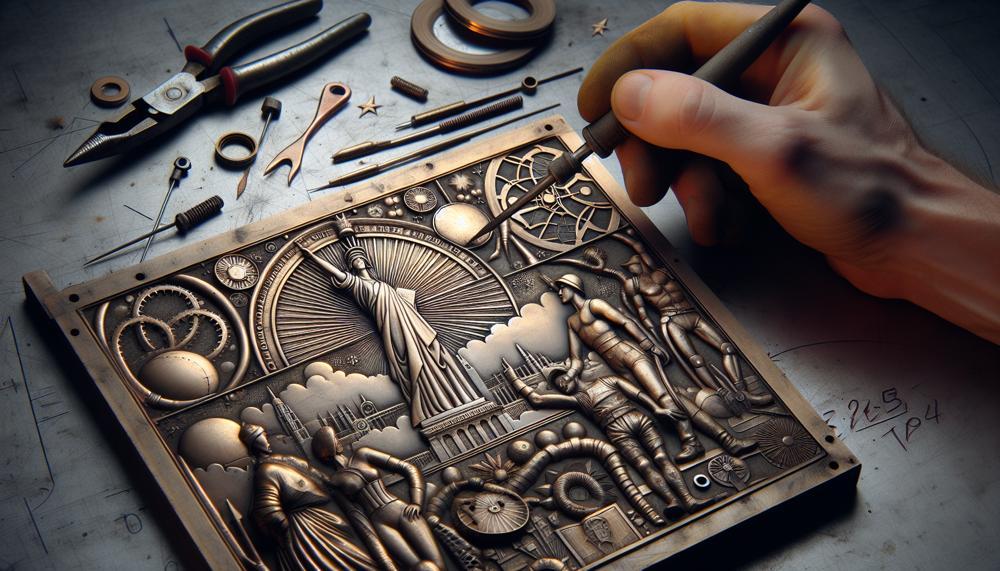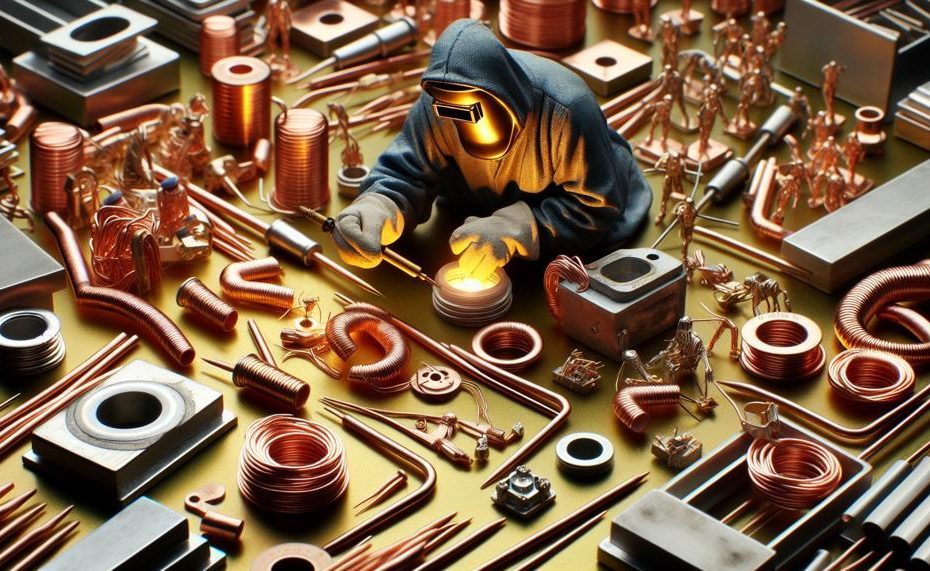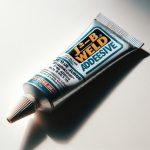Embarking on the journey of soldering, one opens the door to a world where metals meet and meld, creating bonds that are both strong and conductive. This ancient technique, refined through centuries, stands today at the core of numerous industries, from intricate jewelry making to the high-stakes realm of electronics manufacturing. Yet, as foundational as soldering is, the diversity of metals that can be coaxed into union through this process is often underestimated.
In this comprehensive exploration, we aim to unravel the mysteries surrounding the various metals amenable to soldering. Our discussion will not only illuminate the science behind soldering but also offer practical insights into its applications, making the knowledge accessible to hobbyists and professionals alike.
So, what metals can be soldered?
You can solder copper, brass, bronze, gold, silver, and tin. At temperatures between 400 and 800 °F, you can use solders and fluxes that are easy to find to join these metals together with a soldering iron or a gas torch.
For metals to be suitable for joining, their melting point must be low enough so that they can mix with the solder to form a mixture. Unfortunately, you can’t solder aluminum, stainless steel, or titanium because they have high melting points and don’t mix with solder.
It’s not always easy to join metals together. Some of the easier ones are copper, zinc, brass, silver, and gold. Nickel, iron, and mild steel are also hard because their oxide layers are thin but strong.
For solder to stick to aluminum, it needs to be heated to at least 300°C. And the temperature of the metal, not the heat source, is what you need to measure.
So, let’s dive in.
Contents
What is Soldering?
Soldering is akin to a gentle art in the realm of metalworking, striking the perfect balance between simplicity and precision. It’s a method where folks melt a filler metal, known as solder, to bind bits of metal snugly together.
This technique finds its charm in the ease of use and its knack for fusing a variety of metals.
Here’s the nitty-gritty of soldering, served straight up:
Process of Soldering:
- Preparation: Clean the metal surfaces to be joined. Dirt and grease are no friends of a strong solder joint.
- Heating: A soldering iron or torch introduces heat, coaxing the solder to melt without a fuss.
- Applying Solder: Melted solder is introduced to the joint, weaving into the crevices by capillary action.
- Cooling: The solder cools, hardens, and cements a bond between the pieces, solid as an old friendship.
Uses in Metal Joining:
- Electronics: Soldering is the backbone of electronic assemblies, holding components with steadfast certainty.
- Plumbing: Copper pipes get a watertight handshake through soldering.
- Jewelry: Brings together metals with the delicacy of a poet’s verses, creating intricate designs.
Here’s a simplified glance at the materials and their dance in soldering:
| Metal Type | Common Uses | Solder Type |
| Copper | Plumbing, Electronics | Lead-based, Tin-lead |
| Brass | Decorative, Fittings | Lead-based, Silver |
| Aluminum | Lightweight Structures | Aluminum-specific |
| Silver, Gold | Jewelry | Silver-based, Gold-based |
| Iron, Nickel | Heavy-duty Applications | Nickel-based |
Metals That Can Be Soldered
Soldering is a skilled craft, blending heat, metals, and patience to form steadfast unions. Not every metal takes kindly to this process, but many do, each with its own quirks and demands.
Here’s a clear rundown of metals you can invite to the soldering party:
| Metal | Solder Type | Notes |
| Copper | Soft and Hard | Champion of conductivity, a breeze to solder. |
| Brass | Soft and Hard | A sturdy alloy, plays well with most solders. |
| Silver | Soft and Hard | Precious yet pliable, a jeweller’s delight. |
| Gold | Hard | Opulent, yet obliging when heat is applied. |
| Nickel | Soft and Hard | Resilient, requires a bit more heat. |
| Aluminium | Specialised | Tricky, demands specific solder and technique. |
| Stainless Steel | Specialised | Stubborn, but not impossible with the right approach. |
| Titanium | Specialised | Challenging, yet achievable with expertise. |
Remember, the key to a strong bond lies not just in the metal, but in the harmony of the right solder, the correct temperature, and impeccable timing.
Metals That Cannot Be Soldered
Soldering, a process essential for creating strong, conductive, and durable joints in various applications, finds its match in metals that challenge its effectiveness. Certain metals resist the soldering process due to their inherent properties, making them unsuitable for conventional soldering techniques.
Understanding which metals defy soldering and the reasons behind their resistance is crucial for professionals and enthusiasts in the field of welding and metalwork.
Here’s a concise look into the metals that pose challenges to soldering and the underlying reasons:
| Metal | Reasons for Soldering Difficulty | Key Characteristics |
| Aluminium | High melting point and a stubborn oxide layer that hinders bonding | Lightweight with high corrosion resistance |
| Titanium | Reacts with oxygen at high temperatures, creating a non-conducive surface for soldering | Exceptional strength-to-density ratio, highly corrosion-resistant |
| Stainless Steel | Chromium content forms a protective oxide layer, preventing effective bonding | Durable, resistant to tarnishing and rust |
Aluminium, while celebrated for its lightweight and corrosion-resistant virtues, challenges solderers with its high melting point and an oxide layer that forms almost instantaneously upon exposure to air. This layer acts as a barrier, preventing the solder from properly adhering to the metal’s surface.
Titanium, known for its remarkable strength and corrosion resistance, proves difficult to solder due to its reactivity with oxygen when heated. This reaction forms a surface layer that solder cannot penetrate, requiring specialized techniques for successful joining.
Stainless Steel, admired for its durability and resistance to tarnishing and rust, contains chromium which forms an oxide layer that acts as a protective shield. While beneficial for many applications, this layer also prevents solder from bonding effectively to the stainless steel surface.
For those looking to join these metals, alternative techniques such as welding or using adhesives designed for high-strength applications may be more appropriate.
Other Considerations for Soldering Metals
In the art of soldering, where two pieces of metal are bonded through the melting of a filler metal, the groundwork laid before the solder ever meets the metals is just as pivotal as the act itself.
This prelude to the dance of alloys involves cleaning, fluxing, and heating the metals—a triad of steps critical for a bond that’s not just strong but enduring.
Cleaning the Metals: The First Stride to Purity
| Method | Usage | Why It’s Key |
| Mechanical | Using abrasives like sandpaper | Strips away grime and oxide layers, which if left, form barriers to solder bonding. |
| Chemical | Acidic or alkaline solutions | Dissolves impurities, offering a pristine surface for soldering. |
| Electrolytic | Electric current in a solution | Targets and removes contaminants through ion exchange, ensuring cleanliness. |
Fluxing the Metals: The Guardian Against Oxidation
Following the clean sweep, fluxing is the application of a chemical agent to the prepared surfaces, warding off oxidation when the heat rises.
Flux acts as a cleaning agent itself, removing or preventing any additional impurities from surfacing during the soldering process.

Heating the Metals: The Prelude to Fusion
Pre-heating the metals ensures any moisture or remnants from the flux are evaporated, and the metals are at an optimal temperature for soldering.
This step is tailored to the metal’s nature—direct flames for those with lower melting points and indirect heating for the more stubborn, high-melting-point metals.
Why This Preparation Trilogy Matters
Imagine a bond formed without this care—weak, unreliable, a betrayal waiting to happen. The preparation ensures the solder flows and adheres as it should, creating joints that hold steadfast under stress. It’s a testament to craftsmanship, where skipping a beat in the preparation can lead to failure.
Choosing the Right Metal for a Soldered Joint
When deciding on the right metal for a soldered joint, several critical factors come into play. These elements not only influence the strength and durability of the joint but also its suitability for the intended application. Here’s a concise table that breaks down these crucial considerations:
| Factor | Description | Example |
| Intended Application | Metals are chosen based on their properties fitting specific uses. | Copper for plumbing, Silver for electronics. |
| Durability and Corrosion Resistance | The metal should resist wear and environmental elements. | Stainless steel for moisture-rich environments. |
| Melting Point | Select a solder with a lower melting point than the metal to avoid damage. | Soft solder for copper pipes. |
| Compatibility with Flux | Ensure no adverse chemical reactions between metal and flux. | Rosin flux for electronic soldering. |
| Difficulty Level | Some metals require specific solders and techniques. | Aluminum needs specialized solder. |
| Surface Preparation | Adequate cleaning and treatment of the metal surface are essential. | Cleaning agents for removing oxidation. |
| Joint Type | Choose appropriate heat and reinforcement for the joint. | Extra support for load-bearing joints. |
Conclusion
As our in-depth look at the world of soldering comes to a close, we find ourselves at the point where old skills meet new technology, where joining metals together is both an art and a science. Soldering has been around as long as metallurgy, and it shows how complicated and useful metals are. Each metal has a unique story and responds differently to heat and glue. From soft, beautiful copper and silver to tough, durable aluminum and stainless steel, soldering works with a wide range of materials, and each one needs a different method to make strong, long-lasting connections.
This study shows not only how complicated soldering is but also how many different ways it can be used, from the small circuits in electronics to the strong connections in plumbing systems to the detailed designs in jewelry. The article shows how important it is to know the differences between metals, how different solders work, and how important it is to prepare. It shows that the strength of a soldered joint is not just in the metal or the solder but also in how well the technique, temperature, and timing work together.
For both artists and engineers, soldering is still an important skill that connects the past and the future by making links that are both conductive and unified.





